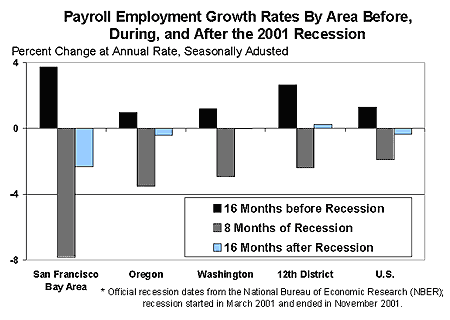That’s an excellent question for the Twelfth Federal Reserve District in the year 2003.1 Since the onset of the most recent national recession in the U.S. that began in March 2001, a number of regional and state economies, including some in the Twelfth District, have experienced more dramatic downturns than the rest of the nation. However, monetary policy is implemented at the national level, in the nationwide financial market. Therefore, the Federal Reserve’s policy tools are not effective or intended to stimulate selected areas of the nation. Before I provide more details, let’s take a closer look at what happened during the 2001 recession.
Regional recessions in 2001
Regional recessions are not a new phenomenon—as residents of Southern California in the early 1990s, New Englanders in the late 1980s, and Texans in the mid-1980s can attest. The 2001 recession hit several areas of the Twelfth District especially hard. The San Francisco Bay Area, Oregon, and Washington, (see Chart 1) experienced much more rapid payroll job losses than the nation during the 2001 recession. The National Bureau of Economic Research (NBER) has announced that the recession that began in March 2001 ended in November 2001. The Bay Area, along with Oregon and Washington, with their heavy concentrations of activity in the high-tech sector, were hit especially hard when the dot-com bubble burst and the technology sector took a sharp downturn. Moreover, in the 16-month period from November 2001 to March 2003, when the national economy was in a recovery, the San Francisco Bay Area continued to experience job losses at a rapid pace.
Chart 1

So, why doesn’t the Fed attempt to improve regional economic conditions in these areas using monetary policy?
The short answer is that monetary policy in the United States is a “blunt instrument” that can not be selectively used to stimulate the economies of particular regions or industries. The Fed’s monetary policy tools, primarily open market operations, are effective nationally because in today’s environment financial markets are national—and sometimes international—in scope.
The Federal Reserve Bank of San Francisco’s publication, U.S. Monetary Policy: An Introduction, provides more details about open market operations and insight into why the Fed’s goals don’t include helping regions of the country that are suffering from either a regional recession or that suffer the most in a national recession.
Often, some state or region is going through a recession of its own while the national economy is humming along. But the Fed can’t concentrate its efforts to expand the weak region for two reasons:
First, monetary policy works through credit markets, and since credit markets are linked nationally, the Fed simply has no way to direct stimulus to any particular part of the country that needs help.
Second, if the Fed stimulated whenever any state had economic hard times, it would be stimulating much of the time, and this would result in excessive stimulation for the overall country and higher inflation.
But this focus on the well-being of the national economy doesn’t mean that the Fed ignores regional economic conditions. Extensive regional data and anecdotal information are used, along with statistics that directly measure developments in regional economies, to fit together a picture of the national economy’s performance. This is one advantage to having regional Federal Reserve Bank Presidents sit on the FOMC: They are in close contact with economic developments in their regions of the country.
As noted in U.S. Monetary Policy: An Introduction, each of the 12 Federal Reserve Banks has a staff of regional economists who carefully analyze and monitor economic conditions in their Districts as part of the briefing given to their Reserve Bank presidents before they attend federal open market committee (FOMC) meetings.
Much of the research and analysis of the Reserve Bank staff is available to the public through Bank publications and Websites. For example, several good sources of information on the regional economy in the nine states served by the Federal Reserve Bank of San Francisco—Alaska, Arizona, California, Hawaii, Idaho, Nevada, Oregon, Utah, and Washington—may be found in:
Western Economic Developments: Analysis of current economic conditions in Twelfth District states; published quarterly. /publications/economics/wed/index.html
Twelfth District Beige Book Summary: Summary of regional economic conditions in the 12th District that is published about two weeks before each of the FOMC’s eight annual meetings. http://www.federalreserve.gov/FOMC/BeigeBook/2003/
FRBSF Economic Letter: A short essay on a current economic topic—including regional subjects. Economic Letters are published most weeks of the year. /publications/economics/letter/index.html
Endnotes
1. The same constraint also occurs in the European Union (EU), where monetary policy is now made at the level of the European Union, rather than at the national level. Essentially, these nations have decided that the benefits of a single monetary policy for the EU outweigh the loss of the ability to make monetary policy at the national level.
Further Resources
Cogley, Timothy and Desiree Schaan. 1994. "Should the Central Bank Be Responsible for Regional Goals?" Federal Reserve Bank of San Francisco, 1994-25, July 15, 1994.
/publications/economics/letter/1994/el94-25.pdf
Laderman, Liz. “Increased Stability in Twelfth District Employment Growth.” Economic Letter, Federal Reserve Bank of San Francisco, 2003-02; January 31, 2003. /publications/economics/letter/2003/el2003-02.html
Lansing, Kevin J. “Growth in the Post-Bubble Economy.” Economic Letter, Federal Reserve Bank of San Francisco, 2003-17; June 20, 2003. /publications/economics/letter/2003/el2003-17.html
Western Economic Developments, Federal Reserve Bank of San Francisco, June 2003. /publications/economics/wed/2003/wed0306bk.pdf